Tips and Tricks for Hiking with Dogs
If you’re a dog lover and searching for the perfect hiking partner, you’re in luck! We are firm believers that there is no better hiking buddy than your pup.
If this is your first time hiking with dogs, there are a few important points to consider both to keep everyone safe and make sure you both have a great time.
We’re here to help with this guide to hiking with dogs including first-hand knowledge that we have picked up over the years.

This post contains affiliate links, which means if you click and buy, we will make a commission (at no cost to you). See my full disclosure policy for more details.
How Do I Start Hiking with My Dog?
Are you excited to plan your first trip hiking with a dog? If so, you may be wondering if there are any preparations that should be done ahead of time to help your dog get ready.
Like any new activity, introducing your dog to the world of hiking may be a process.
Some dogs will jump right into the idea, confidently tackling the local trails next to their person.
But there are other dogs that will need a little adjustment time. Especially if your local trails are quite popular.
For your first trip, try to choose a trail that is a little quieter. This will help to prevent any stress or anxiety from being surrounded by a large group of strangers.
Be prepared for the fact that your dog may be distracted along the way, especially on the first hike. There are a lot of new smells to explore along the trail.
One of the great benefits of hiking with dogs is the mental stimulation that your dog will experience from checking this all out. So, take your time and let him smell the roses (and the grass… and the trees… and the rocks…).
Focus on keeping your dog on the trail. Leaving the trail may be tempting, especially if he’s following a new scent. But leaving the trail can cause more trouble than it’s worth.
Your dog may encounter dangerous wildlife, poisonous plants, or other hazards that can’t be seen from the safety of the trail.
It’s also important for the well-being of the ecosystem in that area as it stops him from trampling important plant life.
For your first trip, start with a shorter trail. If your dog hasn’t been walking long distances, he will need to work up to doing so on the trails.
Bring plenty of fresh water in a dog-friendly water bottle, or pack a collapsible dish. During your hike, take plenty of water breaks, especially if the temperatures are higher.
How Do I Prepare My Dog for Backpacking?
If you enjoy backpacking and backcountry camping, you can bring your pup along for the adventure. But these longer trips may take a little more preparation than a basic hiking trip.
Backpacking generally involves a longer trek while carrying your gear into a remote location.
For this to work with your dog, you will first want to make sure that he is comfortable hiking as well as comfortable sleeping in a tent.
Start with smaller hikes and slowly build upon the distance that you are travelling.
Not only is this a good opportunity to help your dog work up to a full-day hike, but you can also use the time to try hiking with your pack, adjusting your gear, and finding out what will work best for your own comfort on the trail.
Especially if this is your first time with the added gear that bringing a dog requires.
If you haven’t previously taken your dog tent camping, try setting the tent up at home so that your dog can start to get used to it in a comfortable and familiar setting.
With the smaller size of most backpacking tents, you may be able to do this right in your living room.
You will need to pack plenty of water for this longer trip as well as food to fuel your dog along the way.
When packing food for your trip, bring extra. You never know when something might come up forcing you to stay out in the wilderness longer than originally planned.
Can Small Dogs Do Long Hikes?
While our pack here at The Kas Pack is made up of medium and large-sized dogs, that doesn’t mean that you can’t enjoy the great outdoors with a small dog by your side. But there are going to be some unique needs and concerns.
For example, a smaller dog may wear out faster on a trail and need to be carried on longer hikes.
You need to know your dog, his limits, and how to make the experience comfortable and enjoyable for him.
If you’re looking for hiking and camping advice from a small dog lover, check out Jessica’s website You Did What With Your Wiener where she shares her adventures travelling with her dachshunds.
What Do Hikers Do with Dog Poop?
A common question that we hear from fellow dog lovers is what should be done with dog poop while hiking and camping.
Can you just leave it to decompose in the woods?
The truth is that your dog’s poop could have a dangerous impact on the local ecosystem if it isn’t picked up.
The levels of nitrogen and phosphorus from eating a balanced canine diet are different than the levels that are naturally present in the soil.
When these levels are changed, it can have a direct impact on the soil and vegetation in the area.
If the natural vegetation is unable to grow as it normally would, wildlife that relies on those plants for food will then feel the shortage. This will continue to create a ripple up the food chain.
When your dog’s poop is left closer to the trail, or even on the trail, it can also ruin the experience for other hikers.
When it comes to your dog’s waste, follow the rules of ‘leave no trace’. This means packing poop bags, picking up after your dog like a responsible dog owner, and taking it with you when you leave so that it can be disposed of properly.
At What Age Can a Dog Go Hiking?
The good news is that hiking is a safe experience for dogs of all ages. But you may need to make some changes to how you approach your hiking trip depending on which stage of life your dog is in.
This could also vary based on your dog’s health and any medical conditions.
If you are concerned about your dog’s medical needs, contact your veterinarian. Share your potential plans and allow them to assess whether your dog is healthy enough to join in or if any special accommodations.
Is It Safe to Go Hiking with a Puppy?
Hiking with a puppy is a fun way to introduce your dog to the great outdoors and your active lifestyle.
However, there are some serious concerns when it comes to bringing younger puppies camping and hiking in the wilderness before they are fully vaccinated.
This is due to the fact that wildlife like foxes, coyotes, and raccoons can carry serious and potentially deadly diseases like distemper and parvovirus.
If you are planning on bringing a young puppy out, the best rule of thumb is not to allow your puppy to touch the ground at a young age.
This doesn’t mean that he must be left at home. He will need to be carried for the entire duration of the hike. There are special backpacks to carry dogs in a way that is most comfortable for both dog and owner that you can use.
If you do need to stop at some point along the way for your dog to go to the bathroom, make sure to pack puppy pee pads.
Place the pad on the ground and set your dog on the pad. This will provide a protective barrier between your puppy and the ground below.
You must wait 2 weeks after your puppy’s second set of vaccinations before he will have built up the immune response necessary to ensure that he’s protected.
At that point, he can hike on the ground for short distances, but may still need to be carried on longer trips.
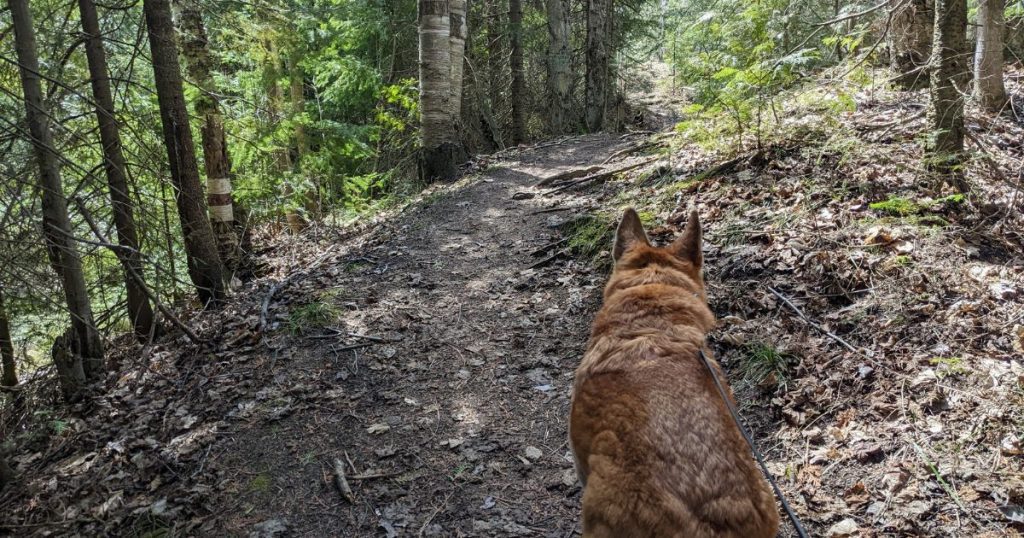
Can Senior Dogs Enjoy Hiking?
As your dog enters the golden years, you don’t need to hang up your hiking boots. He can still enjoy exploring the trails with you with a few little changes.
The biggest thing to consider is his comfort level when up and moving.
If your dog is experiencing arthritis or starting to slow down energy-wise, you may need to choose shorter or easier-to-navigate trails.
You may also need to take more frequent breaks for your dog to drink some water and rest before going on.
In our pack, two of our dogs are now considered to be senior dogs. Indiana is officially 10 years old while Daviana is a beautiful 14-year-old pup.
They may not be able to move quite the way that they used to when they were younger, but they both enjoy exploring the great outdoors with us as often as possible.
In fact, they get a spark in their eyes and a skip in their step as soon as we hit the trails.
Should You Hike with your Dog on a Leash?
When hiking with dogs, one great debate is whether your dog needs to be leashed.
Both on-leash and off-leash hiking have benefits and potential challenges. To decide whether you need to be using a leash, there are a few factors that you should consider.
Be Respectful of Leash Laws
Before you head out to enjoy the local hiking trails for dogs, take some time to research the rules for that location.
While many trails do allow off-leash dogs, there are also some that have strict leash laws in place. This is especially common at the Ontario Parks where almost every trail requires that dogs be leashed.
Leash laws are in place to create a safe and comfortable place for everyone to enjoy. This includes dogs that are comfortable around others, dogs that are skittish around unknown dogs or people, cats, and people that are afraid of dogs.
Don’t be that dog owner who believes they are above the rules regardless of how it could impact others.
At the same time, you need to be aware of off-leash areas if you are hiking with a reactive dog.
If you are heading out somewhere where dogs are allowed to run without a leash, there is a much higher risk of an unknown dog coming up to your dog.
If you know that it may create a dangerous situation, stick to on-leash trails where your dog can have fun in a safe and comfortable setting.
Recall Training
Does your dog have reliable recall? This means that he will return to you when called regardless of what distractions may be present nearby.
If you can’t confidently say that your dog will definitely come when called, then he isn’t ready to go hiking off-leash yet. This isn’t to say that he never will, but more training is needed to get him to that point.
Be Aware of Wildlife
When your dog is off-leash, there is always a risk that he will encounter the local wildlife either while in your sight or when he has wandered off.
Pay attention to any warnings in the area. For example, many of our local parks will post warning signs when a bear has been seen within the park’s boundaries.
If there is a higher risk, you may want to keep your dog on a leash in those settings.
With smaller dogs, there is an even bigger risk in terms of wildlife. Your dog could be seen as prey by coyotes, wolves, or even hawks.
While having your dog on a leash isn’t a guarantee that you won’t encounter wildlife, it does give you control over your dog in a dangerous situation allowing you to react as needed.
How Do I Protect My Dog’s Paws When Hiking?
A dog’s paws are much tougher than our own feet, meaning that they can handle a variety of outdoor surfaces without any problems. But that doesn’t mean that there is no potential for problems.
There are times when your dog’s paws may be at risk, and, as any experienced hiker and dog lover can tell you, it is your responsibility to keep them safe.
When planning a hike, pay careful attention to the description of the trail conditions. There are also websites and apps like the AllTrails app that allow other hikers to share their first-hand experiences.
If a trail is overly rocky or uneven, it may be difficult for your dog to navigate. It’s often best to choose another smoother trail.
In addition to the terrain, watch the weather. If the weather is too hot, it can make surfaces like rocks and sand too hot for your dog to walk upon. Rainy weather can create slippery conditions that could lead to injuries.
Always trim your dog’s nails before heading out. When your dog’s nails get too long, they can cause discomfort or pain by altering the way he walks and putting pressure on the wrong parts of his paw. They are also prone to breaking, chipping, splitting, and tearing.
If you know that you are going to be heading out on a longer hike or navigating some rougher terrain, you can toughen up your dog’s paws by building up to it.
Just as you would do with your endurance, start with some shorter dog-friendly hikes on smoother surfaces. Over time, you can extend these hikes longer or introduce new terrain.
Do Dogs Need Shoes for Hiking?
There are products that you can use while hiking with dogs to reduce the risk of injury.
Paw balm is a lotion or wax product that you apply to your dog’s paw pads to moisturize dry paws and provide a protective barrier.
You may also choose to have your dog wear breathable dog hiking boots on rougher or unsafe terrain. Winter dog boots are also a great way to offer traction on snow and ice during winter hikes.
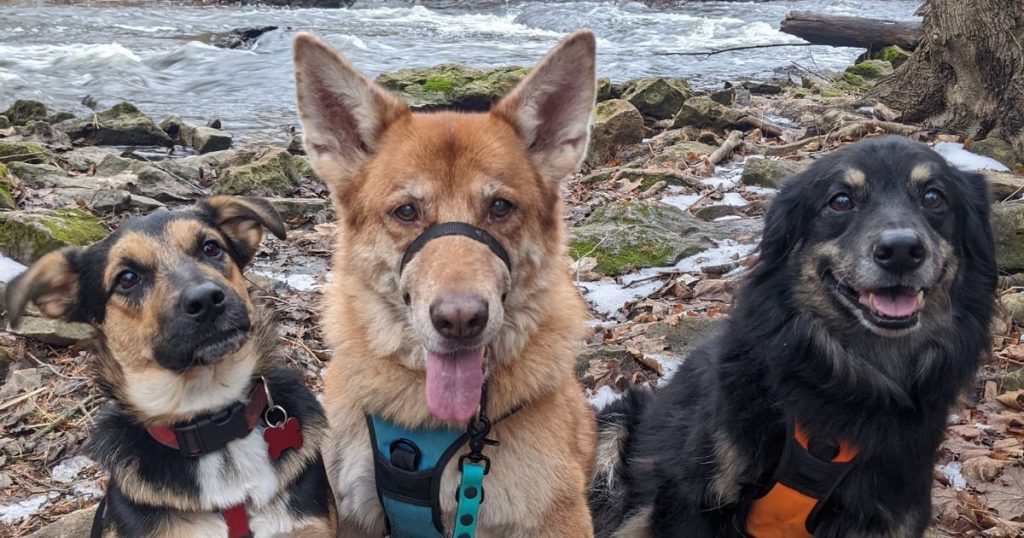
Why Would a Dog Need a Backpack?
There are two types of dog backpacks that you may hear hikers and outdoor travellers discussing. The first are backpacks to carry dogs and the second are backpacks for dogs to carry.
Each of these options can be valuable gear to include in your hiking adventures, depending on your dog’s needs.
Backpacks that are designed to carry dogs are a great choice for pups that may have a hard time keeping up with your hiking plans.
They are available in a wide variety of sizes ranging from small carrier-style bags for cats and toy dog breeds to more heavy-duty dog hiking bags for larger adult dogs.
As a dog parent to a dog with unique medical needs, this is a must-have in our hiking gear. It allows our little man Lucifer to join us on all our outdoor adventures while still limiting the amount of time that he’s active on his feet.
The other type of dog backpack allows your dog to carry some of his own gear when hitting the trails. It’s a popular choice for dog parents who have working breed dogs as it gives them a “job” when out on the trails.
Tips for Hiking with Dogs Safely?
There are many hazards that your dog may face while hiking. The key to keeping your dog safe is to be aware of the risks around you and take steps to prevent problems where possible.
This ranges from the potential problems arising from extreme weather to the possibility of a medical emergency along the way.
Here are a few common risks and how you can be prepared to react accordingly.
Dogs and Ticks on the Trails
In recent years, we have seen several different health units warning about the growing problem of ticks in our area.
Not only are these hitchhikers an annoyance, but they may also be carrying some serious infections or diseases including Lyme Disease, Canine Bartonellosis or Rocky Mountain Spotted fever.
Not every tick bite will result in a tick-borne illness, but it’s not worth the risk! The best solution is to use a reliable tick preventative to keep these pests at bay.
How Do Dogs Stay Cool on Hikes?
Another major risk when hiking with dogs is the possibility of heat exhaustion or heat stroke during the hot summer months.
The best hiking dogs for the summer temperatures are those that were bred to thrive in warm climates. But nearly any dog can enjoy the great outdoors all year long with the right planning.
This means understanding how to keep your dog cool while you’re out and about without the perks of air conditioning.
Before heading outdoors, take some time to consider the best time to visit the trails.
During the hottest days, it will be safer to go hiking early in the morning before the temperature hits its peak or later in the evening when the temperatures have cooled off slightly.
This is especially important if your dog is an arctic breed like a Siberian Husky or Malamute or if you have a brachycephalic dog breed with a shorter snout like the boxer or bulldog.
Make sure to pack plenty of water for both you and your dog and plan to take more water breaks than usual.
You can also make use of summer weather gear designed to cool your dog, such as cooling vests or cooling bandanas.
How Much is Too Much Hiking for a Dog?
When it comes to planning your hiking trips, the distance that your dog can safely cover will depend on his age and fitness level.
A healthy adult dog can hike 30 km or further in a single day without a problem. But not every dog will fall into this category.
If your dog is a senior dog, a young puppy, or a dog that hasn’t been active for a while, you may need to start with a shorter trip and work your way up.
Pay careful attention to how your dog is feeling while you are out exploring. This will help you to adjust on the go if needed.
If you’re unsure of your dog’s personal limit, try visiting a hiking trail with multiple exit routes allowing you to cut your day short.
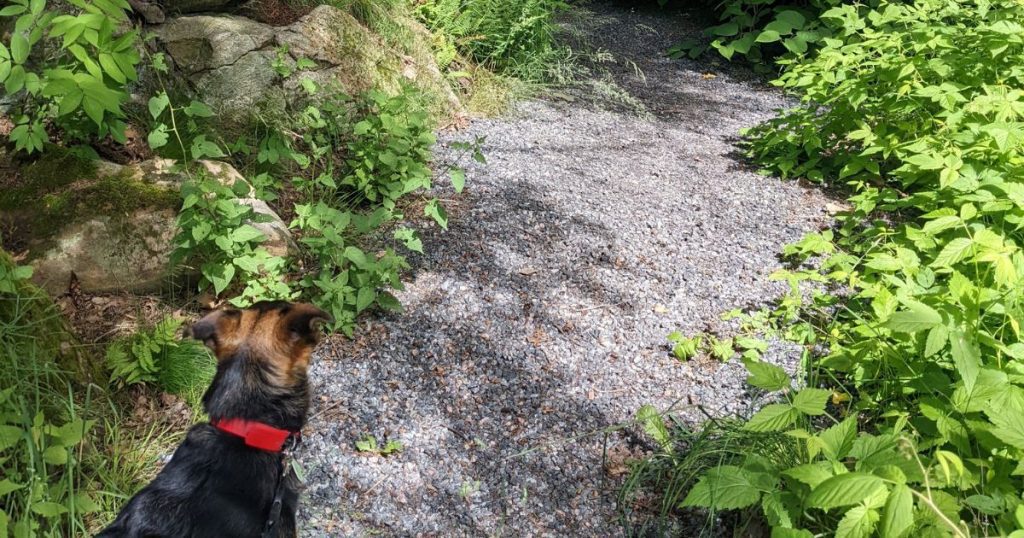
Are Weighted Backpacks Safe for Dogs?
Dog backpacks can be a great option for dogs that need a little extra exercise or who are craving a job to do. However, they need to be used safely to avoid causing injuries.
Before introducing a backpack to your dog, contact your veterinarian and discuss your plans. They will be able to advise you whether it is safe for your dog to carry a pack as well as if there are any unique accommodations you will need to consider.
Every dog’s capabilities are different. Dogs that have been carrying weight for a few years will be able to comfortably carry more than a dog that is wearing a backpack for the first time.
A general rule of thumb is that your dog’s backpack load should not exceed 25% of his body weight.
Some items that you may wish to pack in your dog’s backpack include:
- Dog food and treats
- Collapsible dog bowl
- Water bottles
- Hiking first aid kit
- Garbage bags or dog poop bags
- Rope
- Cooling vests or bandanas
- Dog boots or paw balm
- Lightweight dog toys
- Extra leash or collar
The amount that you can pack is going to depend on the weight of the items you are considering as well as the size of your dog and, therefore, the size of his saddle bags.
Wilderness First Aid Tips for Dogs
Before heading out on any outdoor adventures, you should familiarize yourself with the basics of wilderness first aid for dogs.
This includes some of the more basic first aid requirements like assessing and treating cuts and scrapes as well as taking care of bug bites.
It also means learning the best way to respond to more serious medical emergencies, such as those that may require chest compressions or rescue breathing.
If you’re looking for a dog-focused first aid course in your area, try asking your veterinarian for recommendations.
Dog Hiking Essentials
When packing for a trip hiking with dogs, there is always a few items that we simply can’t be without.
These items on our list of must-have hiking gear are chosen for the way that they improve our trip by making the experience both safer and more comfortable for both us and our pups.
If we were to list every item that we love, the list would be incredibly long.
To try to keep it down to a more manageable size, we have chosen to share a few of our top favourites. These are the items that we truly believe should be essentials for hiking with dogs of all ages.
Mysfit Mutt Biothane Dog Leash & Collar
A reliable collar and leash are an obvious must-have, but these aren’t just any collar and leash!
Made from waterproof, stink-proof Biothane material, our Mysfit Mutt leash and collar are the perfect choices for spending time outdoors.
If your dog is like ours, then they love every aspect of being outdoors. This includes bodies of water and mud puddles that they discover along the way.
All 3 of our dogs wear Biothane collars and use their leashes while hiking for a reason. They are high-quality, easy to clean, and there are many fun colours to choose from.
Adventure Medical Kits Adventure Dog Series Me & My Dog Canine First Aid Kit
As we mentioned previously, first aid while hiking is a necessity. Of course, first aid knowledge isn’t much help if you don’t have the supplies needed to provide this care.
The Me & My Dog Canine First Aid Kit from Adventure Medical Kits is prepared specifically for dog lovers who are spending time outdoors with their pups.
The supplies are stored in watertight bags to keep everything safely protected from the elements.
Alternatively, you can set up your own first aid kit for your hiking adventures using our free Camping & Hiking Pet First Aid Checklists.
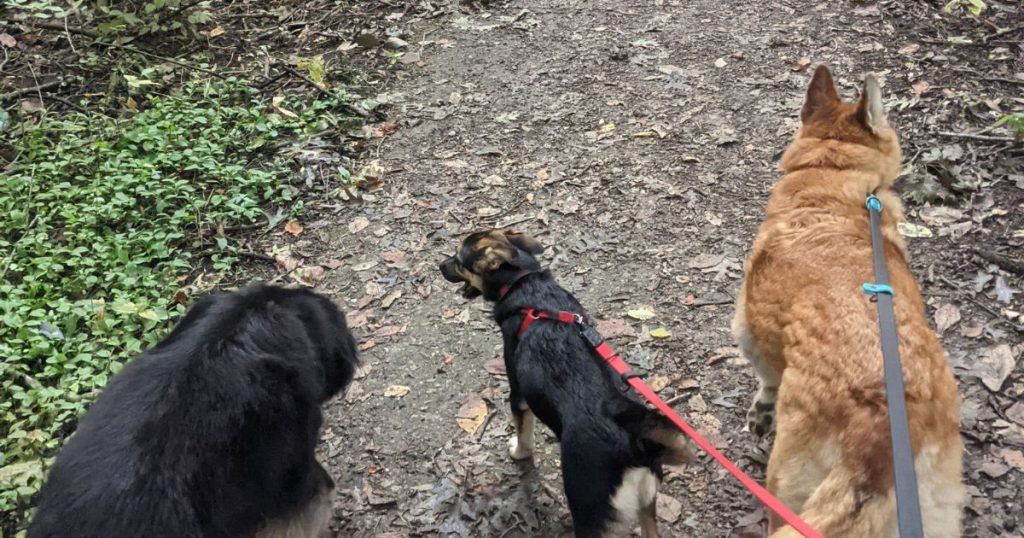
Ruffwear Swamp Cooler Dog Harness
If you plan on taking your dog hiking during the hotter summer months, you may be looking at how to keep your dog cool.
Our girl Daviana is not only a senior dog, meaning she’s more susceptible to the heat, but she also has a thick double coat.
Not only does the Ruffwear Swamp Cooler Dog Harness offer a great harness option from a company that is well-known for their outdoor gear for dogs, but it’s also a swamp cooler to easily cool off your dog with nothing but water.
KONG H2O Insulated Dog Water Bottle & Travel Bowl
One important necessity when hiking, regardless of the time of year, is fresh water along the way. The H2O insulated water bottle from KONG will keep your dog’s water cold in any climate.
It also has an attached travel bowl to make it easy for dogs of all sizes to comfortably drink.
For those who are concerned about protecting the environment, as many outdoor travellers are, this product is made from 100% recyclable and sustainable materials.
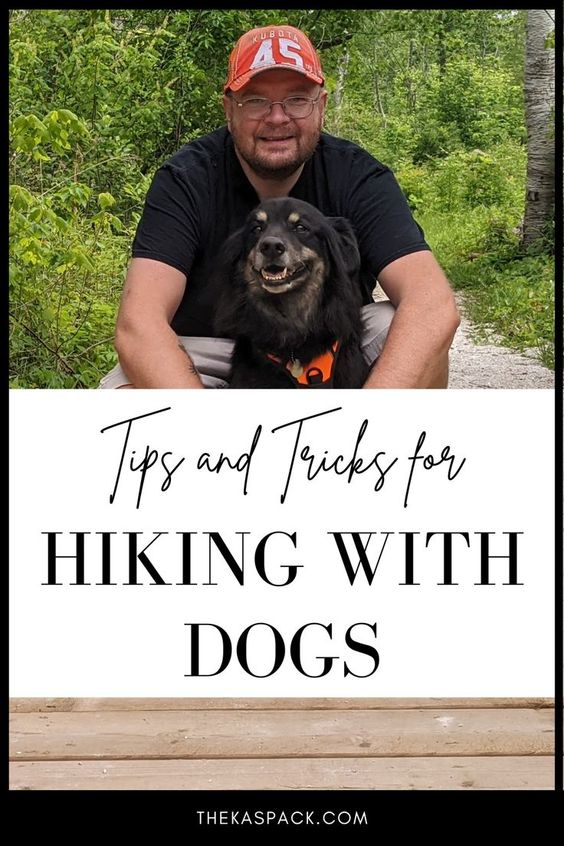
Do you regularly enjoy hiking with dogs? If so, what are your biggest tips and tricks from your outdoor adventures?
Let us know if we missed anything important in the comments and help other dog parents hit the trails with their dogs for the first time.

Excellent tips. You’ve answered so many questions that will be so helpful to others. I’ll be sharing on my FiveSibes Facebook page and Pinning to share with others!
Thank you!